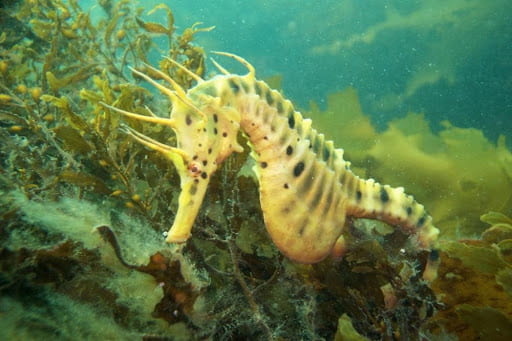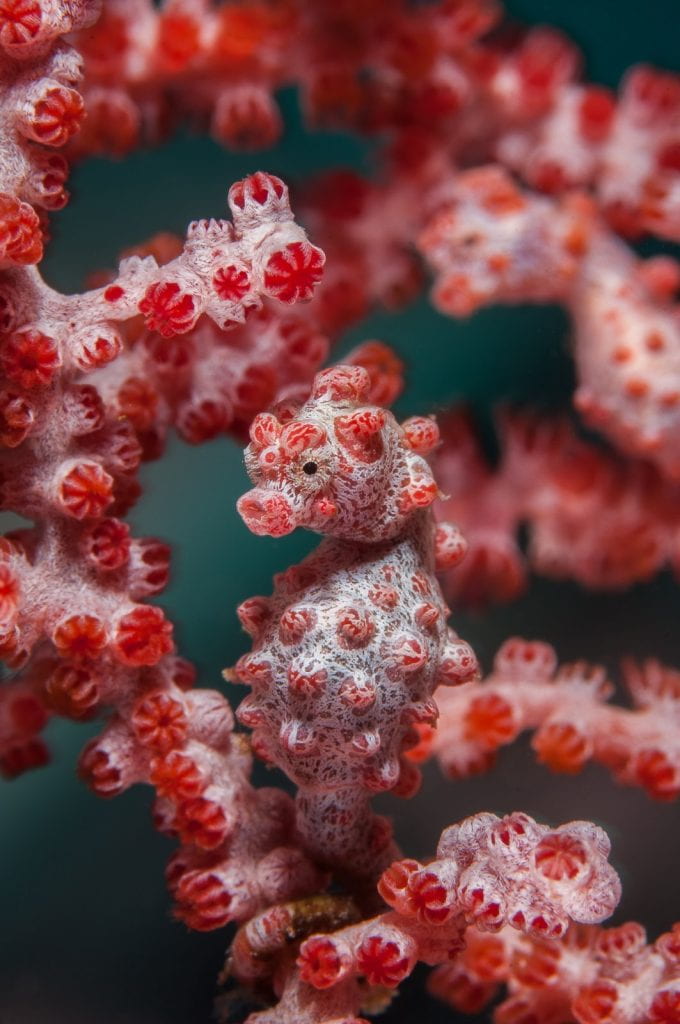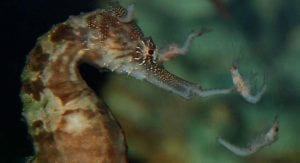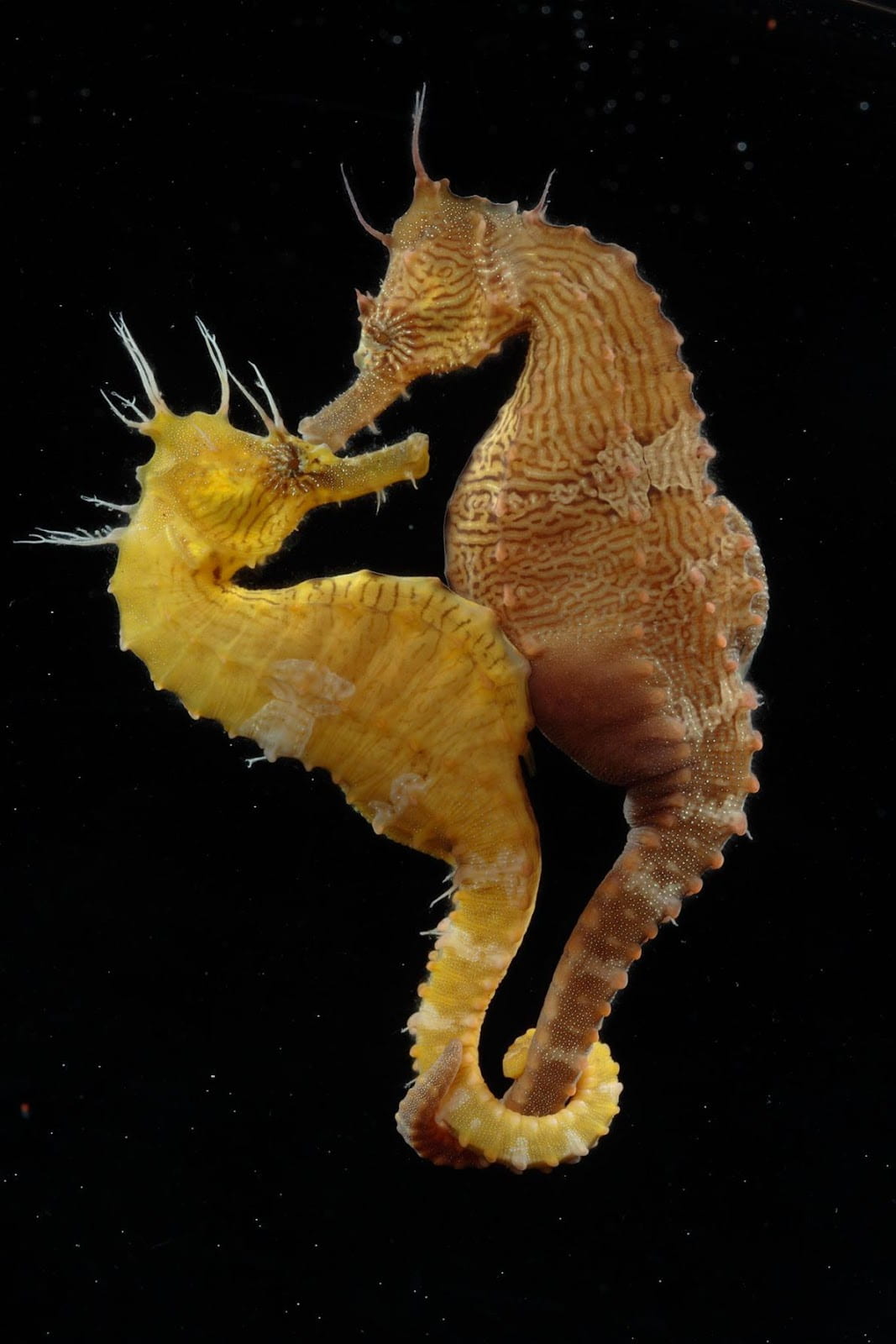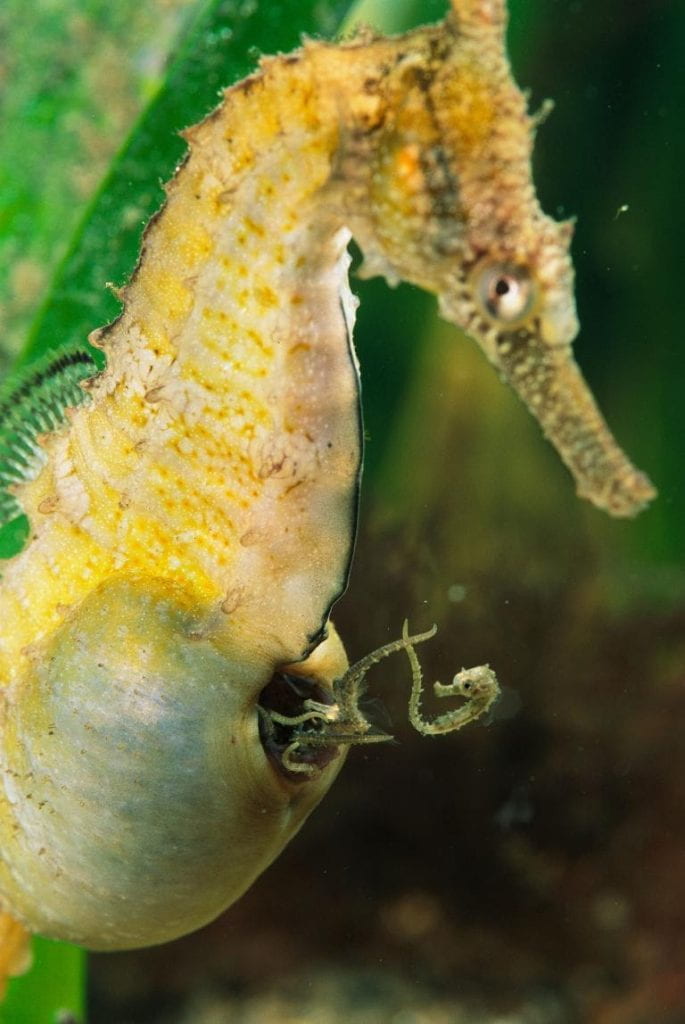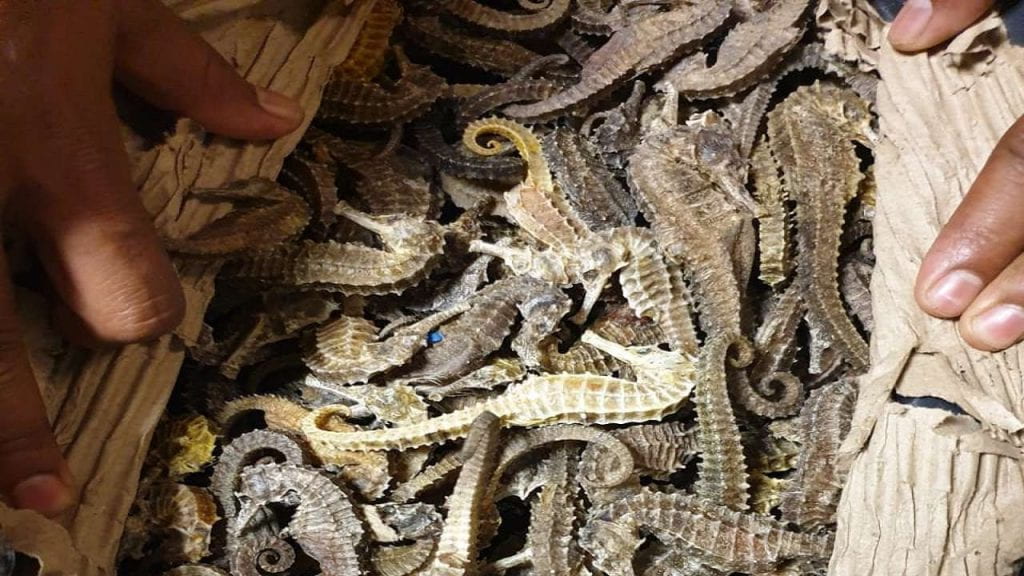All About Seahorses
Seahorses are adorable animals. They are small, colorful, and unique creatures in the animal kingdom. When it comes to precarious megafauna, seahorses are definitely at the top of my list for super cute and interesting animals. Seahorses are beautiful fish native to mangrove forests and seagrass beds in saltwaters. They don’t have scales, but they are still fish. They have gills and swim bladders to help them remain buoyant and to breathe in the water. They have hard exoskeletons and long, snake-like tails to help them. They are very bony fish, making it hard for other fish to digest, hence their lack of natural predators (Ocean Conservancy, 2018). They get their name from having a horse-like head and their Greek name, hippocampus, means horse caterpillar. There are currently 47 species of seahorse in the world, and 14 of these species have been found just in the past 8 years! They range in a variety of sizes too. The largest seahorses are the big-bellied seahorses. They average at over a foot long and live in the waters near southern Australia and New Zealand. The tiniest seahorse is the Satomi’s pygmy seahorse. They are only about a half-inch long and live in the waters of Brunei, Indonesia, and Malaysia.
Seahorses use their snout to suck up food like a vacuum. They don’t have teeth or chew food, but it disintegrates as it gets sucked through the snout, and the snout can expand if the food is larger than itself. Because they digest food so fast, seahorses have to constantly eat to survive (Natural Swimmer, 2011). They are carnivores and eat small crustacea like brine shrimp 30-50 times a day. Baby seahorses, or fry, can eat 3,000 pieces of food a day (Seahorse Trust, 2020). Their good eyesight helps them scout for food. Their eyes work independently of each other. This means they can look backward and forward at the same time. These fish also have the ability to camouflage themselves, making them great hunters; they kill over 90% their prey (Ocean Conservancy, 2018).
When it comes to swimming, seahorses move pretty slowly. Their dorsal fin flaps 30-70 times per second to move left and right, and the smallest seahorse (the dwarf seahorse) has a top speed of five feet per hour (DK, 2020). Seahorses build up gases in their body to help them ascend and descend as needed. As they swim, they resemble a galloping-like posture, and a group of seahorses is relatedly called a herd.
One of the most interesting things about seahorses are their mating patterns. These fish are monogamous and mate with one partner for long periods of time. This enables them to pass through multiple generation cycles in a single mating season. Paired seahorses dance every morning by entwining their tails and moving in rhythmic sequences to greet each other. This helps determine each other’s reproductive status and to make sure each other are both still alive. These dances could last from minutes to hours every day (National Geographic, 2016).
When it’s time to mate, male seahorses give birth to fry. Female seahorses drop their eggs into the male seahorse’s pouch, and he self fertilizes to become pregnant. Males tend to be pregnant anywhere from two to four weeks. Contractions can last up to twelve hours, and males can give birth to over 1,000 fry. Shortly after giving birth, female seahorses are ready to mate again. Baby seahorses, or fry, spend the first couple weeks of their lives looking for food and living along the plankton layer of the ocean. Less than .001% will survive to adulthood (Seahorse Trust, 2020).
Seahorse are fascinating animals. They have unique bodies and interesting mating patterns. They’re also at risk. Humans are the biggest threat to seahorses for several reasons. Firstly, the Chinese traditional medicine market consumes up to 150 million seahorses a year (Seahorse Trust, 2020). It is believed that dried seahorses can be used to cure infertility, asthma, baldness, and arthritis (Chet-Hao Chang, et al.). Because of this, seahorses are harvested in mass quantities that contribute to removing them faster than they can reproduce. The curio trade is another reason for the global decline of seahorses. Many local tourist shops in coastal towns sell seahorses as mementos for tourists. The curio trade kills about 1 million seahorses every year (Pienaar, 2018). Trading wild seahorses for home aquariums kills a massive amount of these fish every year too. Seahorses require optimal conditions to survive; many of these animals die within a few weeks of being in a home aquarium. The market for trading seahorses for home use reaches about 1 million fish every year, and it is estimated that less than 1,000 survive past six weeks (Seahorse Trust, 2020). Habitat destruction is another way to prevent seahorses from thriving. Due to coastal development, coastal reef destruction and deforestation can contribute to suffocating sea beds and killing coral reefs where seahorses live (Endangered Species International, 2011).
Seahorses are being harvested faster than they can reproduce, and it’s leading to a global decline of these beautiful fish. There has been some progress though within the past 20 years to protect them. Seahorses were added to the Convention on International Trade and Endangered Species (CITES) agreement in 2004 (Pienaar, 2018). CITES is an international agreement between 183 parties to help ensure that trade in specimens of wild animals does not impact their survival (CITES, 2020). Since then, work has been done to include seahorses as a threatened species, but large volumes of illegal trade are still an issue (Convention on International Trade in Endangered Species of Wild Fauna and Flora, 2019).
We can make efforts to lessen the decline of seahorses with our own actions. Refuse to buy seahorse souvenirs. These souvenirs are harmful to seahorses and contribute to their decline. Don’t buy seahorses for personal use. These poor seahorses usually don’t survive past a few weeks, and they belong in their natural environments. You can also help by reducing ocean pollution. Many marine species are threatened by pollution. Seahorses living in coastal areas are especially at risk. Lastly, support organizations that care about seahorses and marine life. The Seahorse Trust is an organization focusing on conserving the natural world and especially marine environments. Their flagship species is the seahorse, and you can adopt a seahorse and support them at The Seahorse Trust website. Project Seahorse is an international organization with a focus on finding interdisciplinary solutions to marine conservation. You can support them on the Project Seahorse website. iSeahorse helps identify different types of seahorses and improve our understanding of these fish. They have teams of photographers, scientists, conservation organizations, and seahorse enthusiasts to help. You can learn more about them and support them at the iSeahorse website. Humans are the greatest threat to seahorses today. We have the power to help stop harmful practices against seahorses and support organizations that are focused on their survival. These cute, adorable animals deserve to be protected, and we have the power to do so.
Works Cited
Aylesworth, Lindsay. “10 Things You Never Knew About Seahorses.” 10 Things You Never Knew About Seahorses, 4 May 2018,
ocean.si.edu/ocean-life/fish/10-things-you-never-knew-about-seahorses.
Chang, Chia-Hao, et al. “Authenticating the Use of Dried Seahorses in the Traditional Chinese Medicine Market in Taiwan Using Molecular Forensics.” Journal of Food and Drug Analysis, No Longer Published by Elsevier, 21 Aug. 2013,
www.sciencedirect.com/science/article/pii/S1021949813000434.
“It Can’t Be True! Animals!” Google Books, Google, 2019,
Grall, George. “Romance of the Seas: Strange Mating Habits of the Seahorse.” National Geographic, 25 June 2016,
www.nationalgeographic.com/news/2016/06/seahorse-reproduction-behavior-conservation/.
Hogge, Katie, and Emily Brauner. “7 Wild Facts You May Not Know About Seahorses.” Ocean Conservancy, 21 Dec. 2018,
oceanconservancy.org/blog/2018/12/10/7-wild-facts-may-not-know-seahorses/.
Hogge, Katie, and Emily Brauner. “7 Wild Facts You May Not Know About Seahorses.” Ocean Conservancy, 21 Dec. 2018,
oceanconservancy.org/blog/2018/12/10/7-wild-facts-may-not-know-seahorses/.
“How Seahorses Swim.” How Seahorses Swim, 2011,
www.natural-swimmer.com/seahorses.html.
“How Seahorses Swim.” How Seahorses Swim, 2020,
www.natural-swimmer.com/seahorses.html.
Interpretation and Implementation of the Convention Species Trade and Conservation Issues. 23 May 2019,
www.fws.gov/international/cites/cop18/pdfs/cop18-seahorses.pdf.
Leibach, Julie. “This Tiny Seahorse Has Mastered Its Domain.” Science Friday, 2017,
www.sciencefriday.com/articles/this-tiny-seahorse-has-mastered-its-domain/.
Mailonline, Jack Millner For. “Seahorses Could Be Extinct in 30 Years over Trade in Dried Wildlife Souvenirs.” Daily Mail Online, Associated Newspapers, 31 July 2015,
Potenza, Alessandra. “How a Photographer Snapped This Tragic Photo of a Seahorse Lugging a Q-Tip.” The Verge, The Verge, 15 Sept. 2017,
www.theverge.com/2017/9/15/16314928/justin-hofman-seahorse-plastic-pollution-photography.
“Seahorses Are in Trouble.” Scuba Diver Life, 7 May 2019,
scubadiverlife.com/seahorses-are-in-trouble/.
Singh, Virat A. “Caught in Mumbai: 30 Kg Dried Seahorse Meant for Chinese Medicine Being Smuggled to Malaysia.” DNA India, 8 Mar. 2019,
“Take Actions.” Endangered Species International,
www.endangeredspeciesinternational.org/seahorse.html.
Tiwari, Soma. “This Marine Animal Is a True Romancer.” Scientific Mystery, 28 Aug. 2018,
www.scientificmystery.com/this-marine-animal-is-a-true-romancer/.
